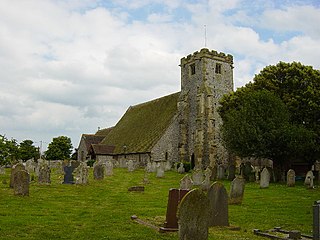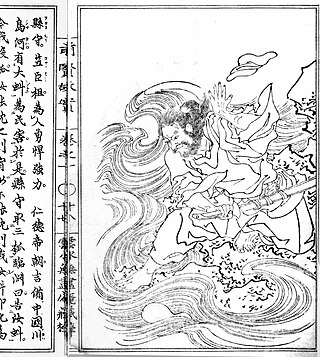Related Research Articles

A dragon is a magical legendary creature that appears in the folklore of multiple cultures worldwide. Beliefs about dragons vary considerably through regions, but dragons in Western cultures since the High Middle Ages have often been depicted as winged, horned, and capable of breathing fire. Dragons in eastern cultures are usually depicted as wingless, four-legged, serpentine creatures with above-average intelligence. Commonalities between dragons' traits are often a hybridization of feline, reptilian, mammalian, and avian features. Some scholars believe large extinct or migrating crocodiles bear the closest resemblance, especially when encountered in forested or swampy areas, and are most likely the template of modern Asian dragon imagery.

In Norse mythology, Jörmungandr, also known as the Midgard Serpent or World Serpent, is an unfathomably large sea serpent or worm who dwells in the world sea, encircling the Earth (Midgard) and biting his own tail, an example of an ouroboros. As a result of it surrounding Midgard it is referred to as the World Serpent. When it releases its tail, Ragnarök will begin.

Sea monsters are beings from folklore believed to dwell in the sea and are often imagined to be of immense size. Marine monsters can take many forms, including sea dragons, sea serpents, or tentacled beasts. They can be slimy and scaly and are often pictured threatening ships or spouting jets of water. The definition of a "monster" is subjective; further, some sea monsters may have been based on scientifically accepted creatures, such as whales and types of giant and colossal squid.

The Nixie, Nixy, Nix, Näcken, Nicor, Nøkk, or Nøkken are humanoid, and often shapeshifting water spirits in Germanic mythology and folklore.

Mon Colle Knights, known in Japan as Six Gates Far Away Mon Colle Knight, is a Japanese manga series written by Satoru Akahori and Katsumi Hasegawa and illustrated by Hideaki Nishikawa. The original concept was made by Hitoshi Yasuda and Group SNE. The series is based on the Monster Collection trading card game.

Princess and dragon is an archetypical premise common to many legends, fairy tales, and chivalric romances. Northrop Frye identified it as a central form of the quest romance.

Lyminster is a village that is the main settlement of Lyminster and Crossbush civil parish, in the Arun District of West Sussex, England. It borders, to the south, Littlehampton, which has its town centre 2 miles (3 km) away.

The Slayer's Slab is a title given to a medieval gravestone formerly in the graveyard of Lyminster church in West Sussex, England. It has now been moved inside the church to protect it from weathering. According to legend it is the gravestone of the dragonslayer who killed the Knucker who lived in the nearby knuckerhole. The stone has a cross on it overlaying a herringbone pattern, but no inscription to identify the tomb's occupant.

Dragons play a significant role in Greek mythology. Though the Greek drakōn often differs from the modern Western conception of a dragon, it is both the etymological origin of the modern term and the source of many surviving Indo-European myths and legends about dragons.
French folklore encompasses the fables, folklore, fairy tales and legends of the French people.

The Mizuchi is a type of Japanese dragon or legendary serpent-like creature, either found in an aquatic habitat or otherwise connected to water. Some commentators perceived it to have been a water deity. It is described in the Nihon Shoki and one Man'yōshū poem.

The Grootslang or Grote Slang is a legendary creature that is reputed to dwell in a deep cave in the Richtersveld, South Africa.

The stoor worm, or Mester Stoor Worm, was a gigantic evil sea serpent of Orcadian folklore, capable of contaminating plants and destroying animals and humans with its putrid breath. It is probably an Orkney variant of the Norse Jörmungandr, also known as the Midgard Serpent, or world serpent, and has been described as a sea dragon.
References
- 1 2 "Dragons & Serpents In Sussex" . Retrieved 1 February 2010.
- ↑ "sussexpast.co.uk" (PDF).
- ↑ "the Antonine itineraries". 27 October 2016. Retrieved 23 July 2020.